
s780 combine
Combine
- Combine Advisor™ package helps to set, optimize and automate main combine functions when conditions change
- Fully automated yield sensor calibration with ActiveYield™ supplies accurate data with no time spent calibrating
- Comfortable S700 cab is common with tractors and sprayers for ease of use
- Continued quality manufacturing of S-Series combines maximizes uptime and productivity
View Product Brochure
Features
ActiveYield delivers automatic yield calibrations to the operator without spending time manually performing yield calibrations.
Feature benefit:
- Simplified yield calibrations for improved uptime in the field
- Simplified data collection for use during and after harvest

Functionality:
ActiveYield eliminates time-consuming manual yield calibrations and replaces them with automated sensors that calibrate the machine by measuring the grain as the tank fills. This enables decisions to be made in real time without leaving the cab.
 ActiveYield sensors in grain tank
ActiveYield sensors in grain tankWhen the ActiveYield option is enabled and the Terrain Compensation Module (TCM) in the StarFire™ 3000 or StarFire 6000 Receiver has been calibrated, ActiveYield is ready to go to work. As grain is harvested and enters the tank, the three sensors within the grain tank collectively measure the grain as it piles over the cross auger covers. If all conditions are acceptable (header and separator on, grain is flowing, and machine level is within 4 degrees) load collection occurs from 900 through 3000 kg (2000 through 6600 lb).
Any pitch and roll of more than 4 degrees from center during load collection will cause the system to reject that load due to the grain pile shifting in the tank. A new calibration load starts once grain is below the sensors on the cross auger covers.
Stored calibration loads are replaced by new ones as the system continues to collect data. The system may be disabled at any time by accessing the moisture setup page and unchecking the ActiveYield box if manual yield calibration is desired.
 ActiveYield calibration location
ActiveYield calibration location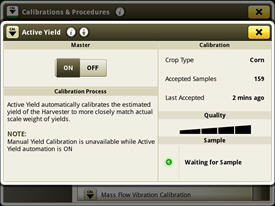 ActiveYield Information
ActiveYield InformationActiveYield is available for model year 2016 through model year 2019 S760, S770, S780, and S790 Combines and requires the 4600 CommandCenter™ Display, GreenStar™ 3 2630 Display, or GreenStar 3 CommandCenter. Additionally, a StarFire 3000 or 6000 Receiver must be installed on the combine with the TCM calibrated for ActiveYield to detect machine pitch correctly. Manual yield calibration is not required as each crop has a built-in default value.
Harvest Doc™ system yield data collected by an ActiveYield system is only compatible with the John Deere Operations Center. John Deere does not guarantee compatibility of ActiveYield collected documentation with John Deere APEX™ software or third-party software systems.
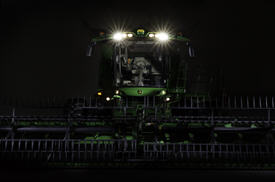
Combine Advisor is a suite of technologies designed to maximize harvesting profits. The features help the operator set and optimize the S700 Combine and then automates the combine to maintain performance target as conditions change. Purchasing Combine Advisor grants access to the Combine Advisor application, which houses three automation technologies: HarvestSmart™ system for automation of feed rate, Active Terrain Adjustment™ system for terrain change management, and Auto Maintain with ActiveVision™ cameras for crop condition change management.
Combine Advisor also provides easy navigation of the S700 set and optimize features: harvest settings application for initial set up and setting storage, VisionTrak system for monitoring losses, and Optimize Performance for step-by-step guidance of combine setting optimization. Once John Deere Combine Advisor is set into motion, the operator will experience ease-of-use benefits coupled with increased productivity.
Code | Description |
1962
| Combine Advisor Base features, plus Active Terrain Adjustment and Combine Advisor. Includes ActiveVision cameras.
Base features include Optimize Performance, TouchSet™ system, VisionTrak, HarvestSmart, and engine speed management. HarvestSmart and engine speed management only included with code 2020 (ProDrive™ transmission). Engine speed management only available with Final Tier 4 (FT4) engines. |
Combine Advisor hardware and software
Combine Advisor bundles are available for model year 2018 and future models. The bundles include ActiveVision cameras, harnesses, Auto Maintain, and software.
Dealer installation instructions are included, as weldments and drilling are required. The process will most likely take around 10 hours of labor.
| Bundle | Description |
BXE11034 | Combine Advisor retrofit bundle for S760 and S770 Combines Also requires BXE10948 Active Terrain Adjustment bundle if the combine is not already equipped with code 1961 (base features + Active Terrain Adjustment) |
| BXE11035 | Combine Advisor retrofit bundle for S780 and S790 Combines Also requires BXE10948 Active Terrain Adjustment bundle if the combine is not already equipped with code 1961 (base features + Active Terrain Adjustment) |
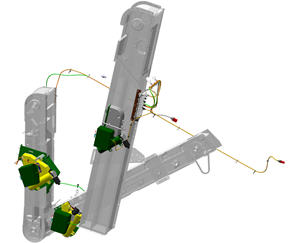 Combine Advisor retrofit bundle components
Combine Advisor retrofit bundle components ICA2 run page, model years 2018 and 2019
ICA2 run page, model years 2018 and 2019 Combine Advisor run page changes beginning with model year 2020
Combine Advisor run page changes beginning with model year 2020| ICA2 run page, model year 2018 | Combine Advisor run page, model year 2020 |
| Section A (yellow highlight): takes the operator to the current settings for concave clearance, rotor speed, fan speed, chaffer clearance, and sieve clearance, giving quick access to critical combine adjustments. | Section A (yellow highlight): takes the operator to the current settings for concave clearance, rotor speed, fan speed, chaffer clearance, and sieve clearance, giving quick access to critical combine adjustments. It also shows the currently selected preset. |
| Section B (blue highlight): the Optimize Performance button helps the operator optimize combine performance. | Section B (blue highlight): the Optimize Performance button helps the operator optimize combine performance. |
| Section C (pink highlight): the HarvestSmart system automates ground speed control during harvest to maintain a constant crop load. | Section C (pink highlight): the HarvestSmart system automates ground speed control during harvest to maintain a constant engine load. The Manage Target with Grain Loss setting enables an automatic target adjustment based on loss levels. |
| Section D (orange highlight): the Active Terrain Adjustment system produces better grain quality and fewer losses while controlling tailings volume when harvesting up and down hills. | Section D (orange highlight): the Active Terrain Adjustment system produces better grain quality and fewer losses while controlling tailings volume when harvesting up and down hills. |
| Section E (green highlight): automation status | Section E (green highlight): Combine Advisor system – HarvestSmart, Active Terrain Adjustment, and Auto Maintain. |
| Section F (red highlight): Auto Maintain monitors the combine and makes adjustments to maintain the performance at the operator-set performance target. | Section F (red highlight): Auto Maintain monitors the combine and makes adjustments to maintain the performance at the operator-set performance target. |
| Section G (purple highlight): Auto Maintain also uses the buttons in section G to allow a glimpse into live views of the clean grain and tailings elevators and allows operators to use an analyzer function to see what Auto Maintain is seeing. It also shows a list of adjustments made by Auto Maintain and Active Terrain Adjustment. **In sections C, D and F select the screen area to see additional sensitivity settings for each system. | Section G (purple highlight): Auto Maintain also uses the buttons in section G to allow a glimpse into live views of the clean grain and tailings elevators and allows operators to use an analyzer function to see what Auto Maintain is seeing. It also shows a list of adjustments made by Auto Maintain and Active Terrain Adjustment. **In sections C, D and E select the screen area to see additional sensitivity settings for each system. |
| Section H (brown highlight): indicates the operator’s priorities for automation | --- |
 |
|
 Historical Auto Maintain performance graph
Historical Auto Maintain performance graphThe ActiveVision cameras can detect broken and unthreshed grain. The cameras will also detect lightweight and heavy foreign material to make the appropriate combine settings changes. The system provides a live feed of both the grain and tailings cameras and will highlight the parameters outlined to make it easier to analyze. The live view and historical graphs update constantly, and the cameras will even tell the operator if there is debris on the lens.
 Grain analysis live view
Grain analysis live view | Combine Advisor with Auto Maintain is available as a factory-installed option on combines since model year 2018. Auto Maintain is compatible in corn, soybeans, wheat, canola, and barley. Retrofit kits, BXE11034 and BXE11035 are available. Please refer to that section for more information. |
Combine Advisor video
- John Deere Combine Advisor Package (full video)
- The following videos are segments of the above full version:
Combine Advisor application
 Combine Advisor run page
Combine Advisor run pageThe Combine Advisor application provides the tools needed to set the combine to get the most out of it and automatically adjust settings to maintain optimum performance. Inside this application on the 4600 CommandCenter™ Display, the operator will find many tools including easy-to-adjust current machine settings, sensitivity settings for automation, application status indicators, automation activity history overviews, and live feeds of grain analysis cameras.
Additionally, the operator can access Optimize Performance, activate the three automation technologies, and set the performance targets the machine will automatically adjust to maintain.
Feature benefits:
- Efficient combine operation with a one-page application for animation technologies
- Improved combine settings management with settings, sensitivities, and status information all on one reference page
- Reduced operator training and efficient, easy control of harvest settings through an intuitive run page and user interface
Functionality:
Auto Maintain
Auto Maintain with ActiveVision cameras is technology that works to automatically adjust five primary S700 Combine settings to maintain the user set performance target. When harvesting corn, soybeans, wheat, canola, or barley, the combine will maintain the performance of everything from grain loss and grain quality, to foreign material in the grain tank. The ActiveVision cameras, along with grain loss monitors, are specifically designed to identify the impact of crop condition changes and adjust the combine to maintain the performance target, allowing the operator to focus on other challenges of harvest.
Feature benefits:
Simplify harvest by automating the critical workload of constantly managing combine settings when conditions change
Increase productivity by allowing ActiveVision cameras to identify and address tough-to-spot problems such as cracked grain
Provide flexibility in planning overall business and increase the efficiency of the combine independent of operator experience
 Combine Advisor run page
Combine Advisor run pageFunctionality
Auto Maintain looks at the level at which the combine is performing, sets that as the goal, and automates combine settings to continually hit the target performance goal over time. Auto Maintain uses existing sensor inputs along with the ActiveVision cameras to make decisions for accurate combine adjustments. It does not use grain moisture as an input, however. Auto Maintain is able to hit the target goal by automatically making adjustments to the threshing speed, concave clearance, chaffer clearance, sieve clearance, and fan speed. The ActiveVision cameras have been trained to analyze the clean grain and tailings material and input that analysis into the Auto Maintain system. Auto Maintain will show the operator how it has been performing with a constantly updating historical graph of losses, grain quality, and foreign material in the clean grain. The green-shaded area below indicates the performance targets set. The colored lines show the ongoing levels of losses and quality. For example, the green, purple, and orange lines below show a period of time outside of the green-shaded acceptable area. Auto Maintain recognizes this and makes the appropriate adjustments to meet the set targets.
Additional Combine Advisor features
The Generation 4 CommandCenter was designed to provide a consistent user experience by providing full-screen viewing of more run page modules, shortcut keys, and precision agriculture capabilities.
Expect easier set-up, along with increased operator confidence, thanks to a simple, customizable interface. The improved design of the Generation 4 CommandCenter also aids in an optimal operating experience and maximizes uptime.
In order to increase your efficiency, take advantage of the following features offered by the Generation 4 CommandCenter:
Layout manager
 Layout manager selection page
Layout manager selection page Layout manager module build
Layout manager module build- Easily create page views that meet your needs and that are also equipped with default run pages.
- Users and access allow the owner or manager to lock out certain functions to prevent operators from accessing or changing settings with a defined four-digit code.
- Gather on-screen help by selecting the help icon on the shortcut bar on the bottom of every page.
Machine monitor
 Machine monitor page
Machine monitor page- The Machine Monitor application provides you instantaneous readings about the status or condition of your machine.
- This application shows parameters such as engine speed, coolant temperature, and ground speed.
Work monitor
 Work monitor page
Work monitor page- The Work Monitor application displays performance information about the task being performed by the machine.
- You are shown averages, totals, and productivity of the machine, such as area worked, average working speed, and fuel usage.
- Work setup places the settings needed to properly setup features such as AutoTrac, Documentation, and Section Control in a single location. Settings include:
- Client, farm, and field
- Crop type
- Machine and implement dimensions
- Variety/hybrid and planting/seeding rates
- Variable rate prescriptions
- Product and application rates
- Application rates through the implement screens
Video capability
- Machines equipped with a 4200 CommandCenter are equipped with one video input, and the 4600 CommandCenter has four video inputs.
- You have the ability to set a variety of triggers. With each trigger, the image will then appear on the display.
Flags
 Create flags to mark items in the field
Create flags to mark items in the field- Mark areas in the field that need special attention such as rocks, tile lines, or weed pressure.
- Flags previously recorded on the Gen 4 or GreenStar™ 3 2630 Display can be transferred between monitors.
- Flags previously recorded on the Gen 4 or GreenStar™ 3 2630 Display can be transferred between monitors.
Field boundaries
 Boundary creation from coverage
Boundary creation from coverage Headland creation
Headland creation- Manually drive field boundaries with the Generation 4 CommandCenter or import existing boundary information from the GreenStar 3 2630 Display or John Deere Operations Center. Gen 4 documentation data can be used to create boundaries from coverage within the John Deere Operations Center.
Dual-display mode
 Dual display
Dual display- Generation 4 CommandCenter may be configured to run with the following John Deere displays connected at the cornerpost of a John Deere tractor:
- GreenStar 2 1800 Display
- GreenStar 2 2600 Display
- GreenStar 3 2630 Display
- 4640 Universal Display
- 4240 Universal Display
NOTE: Vehicle applications will always be located on the Gen 4 CommandCenter.
Automatic base station switching
 Setup base stations in Fields and Boundaries applications
Setup base stations in Fields and Boundaries applications- Customers using John Deere RTK Radio 450 or 900 can link a base station to a desired client,/ farm,/ or field. This allows automatic switching to the associated base station when changing fields. The ability to import base station assignments into Operations Center and send back to machines will be available at a later date.
Video looping supported with Gen 4 4600 CommandCenter Display and 4640 Universal Display
 Scan through videos with video looping
Scan through videos with video looping- This feature enables users to scan or loop through all of the available video feeds for a specified duration. The default scan time is set to 7 seconds per image. The scan time is customizable per image allowing for consistent visibility to all video feeds.

Harvest is hectic. Producers are focusing on getting all the crop from the field to the bin within a tight harvest window. Using Machine Sync, those producers can focus more on grain harvest and grain quality, and worry less about keeping the grain cart under the spout when unloading on the go. Gen 4 Machine Sync provides a solution to harvest stress by creating a wireless network between the tractor and combine to enable on-the-go unloading by synchronizing tractor speed and direction of travel with the combine.
Machine Sync works with In-Field Data Sharing to show the location of all combines and tractors within the fleet of Gen 4 machines harvesting in the field. Knowing the exact location of multiple combines as well as their grain tank fill level and unloading auger status allows the grain cart operators to be in the right place at the right time.
NOTE: Active Concave Isolation is only available on S780 and S790 Combines.
ACI increases throughput in tough threshing small grains and rice without sacrificing overall grain savings. This system allows producers to continue to harvest outside the optimal harvest window and conditions. The concaves are suspended by hydraulic cylinders that increase the amount of crop that is being threshed as well as reduces the amount of rotor noise that is heard by the operator.
Feature benefits:
- In tough threshing, small grains producers can see up to a 10 percent increase in machine capacity while maintaining their loss level when the combine is equipped with a tough crop packages
- In tough material handling conditions, the tough crop packages improve the throughput of the combine up to 20 percent to better utilize true machine performance outside the optimal harvest window and conditions, while accepting increased loss levels
- Improved drivability and ability to handle slugs
- Enhanced durability and uptime with the elimination of sheer bolts in the system
- Increased operator comfort with the reduction of concave banging noise
 ACI
ACIFunctionality:
The ACI feature hydraulically suspends the concaves; the consistency of the concave gap is increased along with decreasing sensor drift for a more accurate concave distance. Material flow through the threshing section of the machine is smoother, giving more consistent threshing.
The Dyna-Flo Plus cleaning shoe is the heart of the S700 Combine cleaning system. The system is made up of a unique design consisting of aluminum and high-strength steel that reduces overall weight while maintaining overall strength. The Dyna-Flo Plus cleaning shoe also features an enhanced drive system that requires only one flywheel for optimal shoe performance and maximizes uptime.
Feature benefit:
- Increased size of the sieve area by 12 percent for up to an additional 0.6 ha (1.5 acres) per hour of productivity.
- Tailings volume reduction of up to 28 percent in coarse grains and up to 14 percent in small grains.
- Weight reduction of 180 kg (396 lb) for smoother operation and reduced combine ground compaction.
 Dyna-Flo Plus cleaning shoe
Dyna-Flo Plus cleaning shoe Enhanced drive system
Enhanced drive systemFunctionality:
The Dyna-Flo Plus cleaning system begins with conveyor augers located beneath the concave area, where the volume of threshed material is highest, to evenly move material onto the cleaning shoe (1). The deep auger troughs provide uniform distribution of material to the cleaning shoe with less bunching, even on sloping terrain and when harvesting up and down hills.
 Dyna-Flo Plus cleaning shoe
Dyna-Flo Plus cleaning shoeOnce grain is on the cleaning shoe, the raised-center front chaffer cleans up to 40 percent of free grain before it reaches the main chaffer (3). High-velocity air from the cleaning fan elevates any light material traveling over the end of the front chaffer, resulting in more aggressive separation of chaff and increased cleaning performance (2). The main chaffer provides grain separation from chaff as the grain passes through the main chaffer to the sieve (4).
The sieve provides proper sizing of grain from material other than grain (5). Any grain that passes through the sieve is elevated to the grain tank while some grain or material other than grain flows to the tailings return system for reprocessing. On S760, and S770 Combines, the tailings material is directed back into the threshing section of the separator for additional threshing. The tailings material on the S780 and S790 Combines are directed to the active tailings return system for additional threshing, and then directed back on the return pan and then onto the main chaffer for additional cleaning (6).
 Harvesting in slopes
Harvesting in slopes Harvesting in rolling ground
Harvesting in rolling groundThe industry-exclusive ProDrive system uses PowerShift™ transmission technology to automatically shift between two speed ranges as ground conditions and terrain change to keep the combine harvesting at the desired ground speed. Valuable harvest time will no longer be lost shifting on hills and when exiting fields to start transporting.
Feature benefit:
- Precise control of the combine speed (when going up or down hills) without the need to continuously monitor and adjust the multifunction control lever
- Retain high levels of productivity through the speed ranges with shift-on-the-go technology
- Maintain ground speed when engaging four-wheel drive (4WD) (if equipped)
- Operator-selected maximum speed within each range, allowing for more precise control of the combine in delicate operations (for example, when hooking up headers)
The ProDrive system on S700 Combines includes an integrated HarvestSmart™ feedrate control system to provide the maximum productivity and reduce operator stress and fatigue.
Functionality:
The ProDrive hydrostatic motor has a higher displacement than the previous hydrostatic systems. Both the pump and motor are variable-displacement components that allow ProDrive to maintain high levels of torque to the ground throughout each of the two operating-speed ranges.
Range one can be set for typical harvesting speeds. Range two can be used when higher speeds are needed during harvest or when transporting the combine.
The ground speed can be infinitely varied within both modes by the operator, using the multifunction control lever on the CommandARM™ armrest console. The multifunction lever regulates the high-capacity, variable hydrostatic pump and motor that drives the ground speed.
Using the navigation tools on the armrest, the operator can dial in the desired maximum-attainable speed within each of the two speed ranges. The maximum forward speed in either range can be set from 0 to 38.6 km/h (0 to 24 mph). The maximum speed in range one cannot be set higher than the maximum speed for range two. For example, if a maximum harvest speed of 13 km/h (8 mph) is desired and set, the full forward position of the hydrostatic control handle will deliver the speed of 13 km/h (8 mph).
The ProDrive transmission is equipped with an electrohydraulic differential lock with a four-pinion differential. Non-ProDrive combines have a two-pinion differential. When operating in muddy, hilly terrain or in sandy conditions that may cause one of the tires to lose traction, this differential lock enables the operator to maintain productivity. If traction is lost, the operator can quickly and easily engage the differential lock by pressing the differential lock button on the CommandARM armrest console. An indicator light within the button alerts the operator that the differential locking feature is engaged.
Platform tilt allows operators to hydraulically adjust the fore-aft pitch of front-end equipment at the touch of a button from inside the cab to adapt to changing crop and field conditions.
Feature benefit:
- Maximizes performance of header in down crop or changing field conditions to extend the harvest day by up to one hour
- Achieves customized fore-aft angle of header with 17 degrees of tilt
- Adjusts from inside the cab, on the go
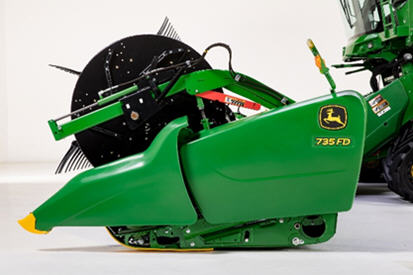 Hydraulic fore-aft feederhouse
Hydraulic fore-aft feederhouse Hydraulic fore-aft multifunction control lever
Hydraulic fore-aft multifunction control leverThe platform tilt feature includes a different multifunction lever (hydro handle) to adjust the feederhouse tilt frame from the cab.
Functionality:
All S700 Combines provide an optional hydraulic header fore-aft tilt capability from the cab. However, all S700 Combines include a front-tilting faceplate as standard equipment. This tilting faceplate allows static fore-aft adjustment of up to 17 degrees of tilt on the feederhouse to accommodate different header and tire combinations to ensure a parallel cutterbar-to-ground relationship. This prevents the cutterbar knife guards from bulldozing or the platform healing on the rear of the skid shoes.
NOTE: Hydraulic fore-aft adjustment range is limited based upon the front-end equipment attached to prevent header frame damage. Check availability in local Price Pages.
The TriStream rotor is unique to John Deere because it features a slightly tapered design in the threshing area for best-in-class grain quality while dramatically reducing the growling that often comes with heavy rotor loads. The TriStream rotor is recommended for producers who harvest mainly coarse grains along with easy-threshing small grains.
The spiral vanes surrounding the rotor guide the crop material through the threshing and separating area in a pull-and-release action to improve performance. This John Deere S700 Combine feature will generate less power consumption.
Feature benefits:
- TriStream rotor technology reduces the force required to move material through the combine by as much as 20 percent, maximizing fuel efficiency.
- The rifling grooves on the threshing elements allow the bullet-shaped rotor to move material more efficiently, maximizing crop threshing performance and grain quality.
- Heavy-duty vanes on the top covers propel the crop smoothly rearward through the length of the rotor, ensuring all the threshed grain is separated.
 S700 TriStream rotor
S700 TriStream rotorFunctionality:
Fifteen cast-constructed threshing elements provide superior material handling with excellent grain quality. The elements spiral around the rotor to control material flow. In some harvesting environments, the dense-pack configuration (nine additional threshing elements) may be necessary.
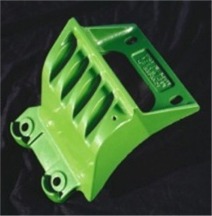 TriStream threshing elements
TriStream threshing elementsConical top covers allow for smooth material movement within the threshing and separating area. The top covers have a radius larger than the rotor, allowing the material to expand as it travels along the top of the rotor. This design uses the pull-and-release action of crop material, aiding in the threshing and separating to reduce power consumption.
 Conical top covers
Conical top coversThe industry-exclusive variable-stream rotor features a tapered design in the threshing section, which improves crop flow, enhances grain quality, and reduces power consumption. The variable-stream rotor with adjustable top cover transport vanes is recommended for producers of rice and in tough threshing conditions.
The variable-stream rotor smooths crop flow during tough handling conditions to maximize throughput. Along with the tough-material handling capabilities of the variable-stream rotor configuration, the straw quality and length can be improved due to the electrically adjustable top cover transport vanes.
Feature benefits:
- The longer rotor taper in the threshing area allows improved material handling by providing smoother crop flow through the combine, maximizing threshing performance and fuel efficiency.
- Electrically adjustable transport vanes allow operators to change the vane angle from the cab for improved straw quality.
 S700 variable-stream rotor
S700 variable-stream rotorFunctionality:
Fifteen cast-constructed threshing elements provide superior handling, improved durability and serviceability, and maintain excellent grain quality. The elements spiral around the rotor to move and control the material. In some harvesting conditions, 12 additional bolt-on threshing tines may be installed for increased material handling.
Rear discharge flights and a tapered rear cone improve material handoff to the rear discharge beater.
Electrically adjustable transport vanes allow operators to change the vane angle within the cab. Longer straw length can be accomplished when vanes are in the advanced position.
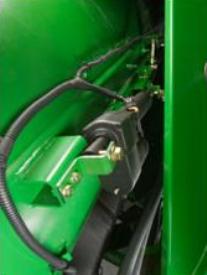 Electric actuator for adjustable vanes
Electric actuator for adjustable vanesSpecifications
Compare the specifications of up to 4 models
| Key Specs | s780-combine Current Model |
|---|---|
| Engine type | John Deere PowerTech™ PSS engine 13.5 L 824 cu in. |
| Rated power | 353 kW 473 hp |
| Fuel capacity | 1,250 L 330 gal. |
| Rotor length | 312 cm 123 in. |
| Rotor diameter | 76.2 cm 30 in. |
| Concave area | 1.1 m2 11.8 sq ft |
| Separating area | 1.54 m2 16.6 sq ft |
| Total cleaning area (louvered) | 5.9 m2 63.5 sq ft |
| Grain tank size | 14,100 L 400 bu |
| Unloading rate | 135 L/s 3.8 bu/sec |
| Engine | |
| Engine type | John Deere PowerTech PSS engine 13.5 L 824 cu in. |
| Emission level | Final Tier 4 / Tier 2 (Australia/New Zealand) |
| Rated speed | 2,100 rpm |
| Rated power | 353 kW 473 hp |
| Power boost @ rated speed | 37 kW 50 hp |
| Fuel capacity | 1,250 L 330 gal. |
| Engine family | |
| Feeding | |
| Drive type | Fixed or multi-speed |
| Conveyor chain slat type | Cast iron |
| Width | 139.7 cm 55 in. |
| Length | 172.5 cm 67.9 in. |
| Feed Accelerator, Stone Trap (FAST) | Reverser Standard Standard |
| Threshing/ Separating | |
| Separator type | Rotary |
| Rotor length | 312 cm 123 in. |
| Rotor diameter | 76.2 cm 30 in. |
| Rotor speed range | 210-1,000 rpm |
| Concave area | 1.1 m2 11.8 sq ft |
| Separating area | 1.54 m2 16.6 sq ft |
| Discharge grate area | 0.45 m2 4.8 sq ft |
| Cleaning | |
| Front chaffer | 0.5 m2 5.4 sq ft |
| Front chaffer extension | 0.8 m2 8.6 sq ft |
| Pre cleaning | |
| Chaffer | 2.5 m2 26.9 sq ft |
| Sieve area | 2.1 m2 22.6 sq ft |
| Total cleaning area (louvered) | 5.9 m2 63.5 sq ft |
| Cleaning fan speed | 620-1,350 rpm |
| Grain handling | |
| Grain tank size | 14,100 L 400 bu |
| Unloading auger length | 6.9 or 7.9 m 22.5 or 26 ft |
| Unloading rate | 135 L/s 3.8 bu/sec |
| Base weight - less head | |
| Manufacturing location | |
Accessories and Attachments
Bracket
10" Tablet Holder Kit - BXE10901
12 Tablet Holder Kit (Ipad Pro) - BXE10864
Camera Observation System
The camera-ready feature is optional on all S700 Combines and provides factory-installed observation camera harnesses and brackets in the grain tank, on the unloading auger, and at the rear of the combine.
John Deere value:
- Provides increased visibility options when unloading grain and maneuvering the combine in and out of the field
- Four integrated camera views on the 4600 CommandCenter™ Display for more convenience
Functionality:
- Quickly install compatible cameras, orderable from Service Parts
- Harness and brackets are provided factory installed, cameras have to be ordered separately via Parts
 Rearview camera location
Rearview camera location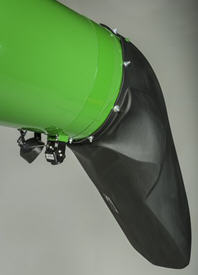 Unloading auger camera location
Unloading auger camera location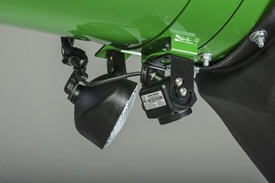 Unloading auger camera location
Unloading auger camera location Grain tank camera location
Grain tank camera location Camera trigger menu
Camera trigger menu- Camera triggers with time menu for:
- Reverse with separator on video trigger
- Reverse with separator off video trigger
- Separator video trigger
- 3/4 grain tank video trigger
- 4/4 grain tank video trigger
- Trigger menu for cameras
NOTE: 4600 CommandCenter is capable of viewing up to four cameras simultaneously.
NOTE: Cameras are not included with factory-installed option. Please order cameras from Service Parts.
Voyager Camera - SWCVMS155B
Voyager One Camera Kit - SWVCMS155JD1
Voyager Three Camera Kit - SWVCMS155JD3
Chaffer And Sieve
3 mm Fixed Round Hole Sieve - AXE68434
The Dyna-Flo Plus cleaning shoe is the heart of the S700 Combine cleaning system. The system is made up of a unique design consisting of aluminum and high-strength steel that reduces overall weight while maintaining overall strength. The Dyna-Flo Plus cleaning shoe also features an enhanced drive system that requires only one flywheel for optimal shoe performance and maximizes uptime.
Feature benefit:
- Increased size of the sieve area by 12 percent for up to an additional 0.6 ha (1.5 acres) per hour of productivity.
- Tailings volume reduction of up to 28 percent in coarse grains and up to 14 percent in small grains.
- Weight reduction of 180 kg (396 lb) for smoother operation and reduced combine ground compaction.
 Dyna-Flo Plus cleaning shoe
Dyna-Flo Plus cleaning shoe Enhanced drive system
Enhanced drive systemFunctionality:
The Dyna-Flo Plus cleaning system begins with conveyor augers located beneath the concave area, where the volume of threshed material is highest, to evenly move material onto the cleaning shoe (1). The deep auger troughs provide uniform distribution of material to the cleaning shoe with less bunching, even on sloping terrain and when harvesting up and down hills.
 Dyna-Flo Plus cleaning shoe
Dyna-Flo Plus cleaning shoeOnce grain is on the cleaning shoe, the raised-center front chaffer cleans up to 40 percent of free grain before it reaches the main chaffer (3). High-velocity air from the cleaning fan elevates any light material traveling over the end of the front chaffer, resulting in more aggressive separation of chaff and increased cleaning performance (2). The main chaffer provides grain separation from chaff as the grain passes through the main chaffer to the sieve (4).
The sieve provides proper sizing of grain from material other than grain (5). Any grain that passes through the sieve is elevated to the grain tank while some grain or material other than grain flows to the tailings return system for reprocessing. On S760, and S770 Combines, the tailings material is directed back into the threshing section of the separator for additional threshing. The tailings material on the S780 and S790 Combines are directed to the active tailings return system for additional threshing, and then directed back on the return pan and then onto the main chaffer for additional cleaning (6).
 Parts included for side hill package
Parts included for side hill packageThe side hill performance package can improve combine performance on slopes up to 8 degrees (14 percent) by substantially reducing cleaning shoe grain loss to acceptable levels.
Feature benefit:
- Reduces grain loss out of the rear of the combine on side hill slopes
- Increases combine productivity by not having to slow down on side hill slopes
Functionality:
The side hill kit installed in the cleaning shoe of S700 Combines allows grain to be evenly distributed across the entire width of the shoe when harvesting in slopes. As grain moves to the rear of the combine, the dividers keep grain contained into four individual bays which prevents overloading one side of the cleaning shoe. Additionally, the rubber agitator paddles in each individual bay work with the oscillating motion of the cleaning shoe to move grain toward the center of each bay for increased utilization of the entire cleaning shoe width for increased performance and productivity.
 Parts included for side hill package
Parts included for side hill packageThe side hill performance package can improve combine performance on slopes up to 8 degrees (14 percent) by substantially reducing cleaning shoe grain loss to acceptable levels.
Feature benefit:
- Reduces grain loss out of the rear of the combine on side hill slopes
- Increases combine productivity by not having to slow down on side hill slopes
Functionality:
The side hill kit installed in the cleaning shoe of S700 Combines allows grain to be evenly distributed across the entire width of the shoe when harvesting in slopes. As grain moves to the rear of the combine, the dividers keep grain contained into four individual bays which prevents overloading one side of the cleaning shoe. Additionally, the rubber agitator paddles in each individual bay work with the oscillating motion of the cleaning shoe to move grain toward the center of each bay for increased utilization of the entire cleaning shoe width for increased performance and productivity.
Deep Tooth Chaffer - AXE60613
Deep Tooth Sieve - For TouchSet Remote Combine Adjustment: S760-S790 - AXE68433
General Purpose Sieve - AXE60449
Concaves And Threshing
Round-bar concaves are standard equipment on corn combines and are recommended for use in corn and soybeans. Additionally, they are recommended for use in specialty crops such as edible beans and food corn.
Feature benefit:
- Provide maximum grain quality and productivity when harvesting corn or soybeans
- Allow versatility to harvest cereal grain crops when paired with the round-bar concave inserts
 Round-bar multi-crop concave
Round-bar multi-crop concave
See concave recommendations to choose the concaves that are best for a grower's operation.
The front concave section is heat treated. All three sections are available to be heat treated as an option or in the extended-wear separator package.
Additional threshing tine base weldments for installation into the DensePack locations of a variable-stream rotor can only be used to improve material handling in some tougher conditions such as rice and grass seed harvest. This may decrease machine performance if used in dry, brittle-crop conditions.
Feature benefit:
- Rice machines ordered from the factory already come with these tines installed for increased productivity and capacity
- Increase in machine performance in tough-threshing and damp crops
 Variable-stream rotor equipped with DensePack
Variable-stream rotor equipped with DensePack Grain wear plates
Grain wear plates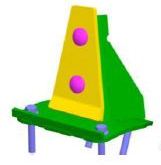 Rice wear plates
Rice wear plates
Wear plate kits (grain versus rice) must be ordered separately through Service Parts.
 Rear of rotor with discharge paddles
Rear of rotor with discharge paddlesRotor discharge flights are available for STS combines when operating in specialty crops. The discharge flights are recommended for use in crops such as sunflowers and edible beans when operating in conditions that require rotor threshing speeds below 300 rpm.
The discharge flights are designed to provide an aggressive push to the slow-moving crop material as it moves from the rotor housing into the discharge beater. The additional kick provided by the paddle design of the flighting significantly improves material flow and reduces possible plugging at the rear of the rotor at extremely low threshing speeds.
When operating in other crops where rotor speeds higher than 300 rpm are required (for example, soybeans, wheat, rice, etc.), it is recommended the discharge flights BE REMOVED to ensure adequate and even material flow through the rotor, as well as to provide better residue spread.
IMPORTANT: Discharge flight paddles are NOT recommended for use in heavy, damp wheat or rice crops.
The discharge flight is for use on any 9650 STS, 9750 STS, 9660 STS, 9760 STS, 9860 STS, 9670 STS, 9770 STS, and 9870 STS Combines and does not require the combine to be fitted with any particular configuration of rotor discharge housings.
NOTE: Two rotor discharge flight paddles for 9560 STS, 9570 STS, and S550 STS Combines, AH219961 and AH219962, can be ordered through Service Parts.
Round-bar concaves are standard equipment on corn combines and are recommended for use in corn and soybeans. Additionally, they are recommended for use in specialty crops such as edible beans and food corn.
Feature benefit:
- Provide maximum grain quality and productivity when harvesting corn or soybeans
- Allow versatility to harvest cereal grain crops when paired with the round-bar concave inserts
 Round-bar multi-crop concave
Round-bar multi-crop concave
See concave recommendations to choose the concaves that are best for a grower's operation.
The front concave section is heat treated. All three sections are available to be heat treated as an option or in the extended-wear separator package.
Small-wire concaves are standard equipment on small-grain combines and are recommended for use in wheat, barley, and other cereal crops. The small-wire concaves are recommended for use in specialty crops such as grass seed.
Feature benefits:
- Provide maximum grain quality and productivity when harvesting small grains
- Allow versatility to harvest specialty crops such as grass seed without having to switch out concaves
 Small-wire concave for small grain
Small-wire concave for small grain
See concave recommendations to choose the concaves that are best for grower's operation.
The small-wire concaves are also available as an option with boronized treatment for extended-wear life. This process penetrates the surface of the concave with a layer of hard, wear-resistant material, extending the life of the concave up to twice as long, and is available in the extended-wear separator package.
IMPORTANT: Not recommended for use in corn.
Large-wire concaves are standard on S700 Rice Combines and available as an option on corn and small-grain combines. They are recommended for rice, sorghum, soybeans, and corn.
Feature benefit:
- Best separating performance in rice to maximize productivity
- Versatility to perform well in soybean harvest, eliminating the need to change out concaves or purchase additional set of concaves
 Large-wire concave
Large-wire concaveLarge-wire concaves are standard on S700 Rice Combines and available as an option on corn and small-grain combines.
They are recommended for rice, sorghum, soybeans, and corn.
See concave recommendations to choose the concaves that are best for grower's operation.
As an option, all three sections can be boronized for extended-wear life. This process penetrates the surface of the concave with a layer of hard, wear-resistant material, extending life up to twice as long.
Large-wire concaves are standard on S700 Rice Combines and available as an option on corn and small-grain combines. They are recommended for rice, sorghum, soybeans, and corn.
Feature benefit:
- Best separating performance in rice to maximize productivity
- Versatility to perform well in soybean harvest, eliminating the need to change out concaves or purchase additional set of concaves
 Large-wire concave
Large-wire concaveLarge-wire concaves are standard on S700 Rice Combines and available as an option on corn and small-grain combines.
They are recommended for rice, sorghum, soybeans, and corn.
See concave recommendations to choose the concaves that are best for grower's operation.
As an option, all three sections can be boronized for extended-wear life. This process penetrates the surface of the concave with a layer of hard, wear-resistant material, extending life up to twice as long.
Rice Performance Enhancement Package - BXE10491
 Concave cover plates for round-bar concaves only
Concave cover plates for round-bar concaves onlyConcave sectionalized cover plates for round-bar concaves help to increase performance in the threshing area in tough conditions and can improve material distribution from the concaves to the cleaning system.
 Concave cover plates for round-bar concaves only
Concave cover plates for round-bar concaves onlyConcave sectionalized cover plates for round-bar concaves help to increase performance in the threshing area in tough conditions and can improve material distribution from the concaves to the cleaning system.
Small-wire concaves are standard equipment on small-grain combines and are recommended for use in wheat, barley, and other cereal crops. The small-wire concaves are recommended for use in specialty crops such as grass seed.
Feature benefits:
- Provide maximum grain quality and productivity when harvesting small grains
- Allow versatility to harvest specialty crops such as grass seed without having to switch out concaves
 Small-wire concave for small grain
Small-wire concave for small grain
See concave recommendations to choose the concaves that are best for grower's operation.
The small-wire concaves are also available as an option with boronized treatment for extended-wear life. This process penetrates the surface of the concave with a layer of hard, wear-resistant material, extending the life of the concave up to twice as long, and is available in the extended-wear separator package.
IMPORTANT: Not recommended for use in corn.
Corn
Engine
110V Pump Kit - SW110VDEFSS
12V Pump Kit - SW12VDEFSS
65 gal. Portable Dispensing Unit with lockable, hinged lid - SWDEFPDU65M
Air Compressor Conversion Kit - BXE10700
Air Compressor Conversion Kit - BXE10701
The rotary screen brush kit adds a series of brushes to the rotary screen. The brushes prevent debris from building up on the screen, allowing full air flow to the engine for cooling.
Engine
275 gal. Tote of John Deere Diesel Exhaust Fluid - SWDEF275
330 gal. Tote of John Deere Diesel Exhaust Fluid - SWDEF330
55 gal. drum of John Deere Diesel Exhaust Fluid - SWDEF055
Fast (Feed Accelerator And Stone Trap)
 Contoured serrated wear strips
Contoured serrated wear strips Regular straight serrated wear strips
Regular straight serrated wear stripsThe serrated feed accelerator wings have a smooth contoured back to provide fast yet gentle crop handling while also featuring serrated edges for positive crop movement in viney crops such as edible beans.
The updated feed accelerator wings are recommended in place of the optional smooth accelerator wear strips attachment because they help to provide excellent grain quality without compromising feeding performance in edible beans.
- NOTE: The standard straight serrated wear strips are still the recommended choice to use on the feed accelerator when harvesting in damp or green-stemmed-type crops.
 Stone trap and stone trap handle
Stone trap and stone trap handle
The stone trap protects the combine's interior area by effectively catching stones deflected by the feed accelerator into the stone dump area before they enter the TriStream™ feed section.
- Remote lever with an over-center latch makes cleanout fast and easy.
- Trap requires no adjustment and provides worry-free harvesting when cutting close to the ground.
- Adds no additional length to the feederhouse. Excellent line-of-sight visibility of the platform cutterbar is maintained.
- No compromise in feeding material smoothly from the platform to the feederhouse conveyor chain.
- No increase in front axle tire loading since feederhouse length is not extended.
Base Equipment On: S-Series Combines
Field-installation information
An expanded stone trap door with a two-piece front feed floor is available as a field-installed bundle. This bundle replaces the standard one-piece feed floor.
When harvesting crops such as corn, food corn, popcorn, and small grains, the front-piece floor section remains bolted in place. This allows 9 in. of opening across the width of the machine.
In rocky conditions such as beans and edible beans, the front floor section is removed to provide 11.5 in. of open area to the larger stone trap, allowing improved rock protection (22 percent increase in stone trap area).
Please refer to the chart below for retro-fit information
 Two-speed feed accelerator handle
Two-speed feed accelerator handle The slow-speed drive reduces the standard two-speed feed accelerator from 450 rpm/800 rpm to 320 rpm/770 rpm.
These lower speeds allow the feed accelerator to provide more gentle grain handling in delicate specialty crops such as edible beans, food corn, or popcorn.
Having the slow-speed feed accelerator drive available as a factory-installed option allows those who plan on using this drive for harvesting all their crops to save the cost of discarding the standard feed accelerator drive parts in the field.
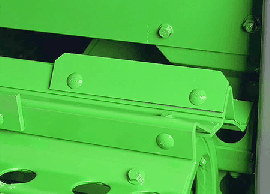 Smooth-wear strips on feed accelerator
Smooth-wear strips on feed acceleratorThe smooth-wear strips provide optimum grain quality in speciality crops such as popcorn and food corn. The bundle includes set of 30 wear strips to replace standard-equipment serrated wear strips.
Spike Feed Accelerator - BH84582
Tine Feed Accelerator - BH84416
Grain Handling
 Grain tank level sensor
Grain tank level sensorThe fast, easy way to let the operator know the combine’s grain tank is full when harvesting on side hills.
Feature benefits:
- Improved accuracy when harvesting in hilly terrain
- Prevents overfilling the grain tank
Functionality:
An additional grain tank level indicator is available to help detect a full grain tank.
The beacon lights are also activated when the combine is in road transport mode.
Door, Regular Duty, Perforated - S660/S760, S670/S770, S680/S780 - BXE10094
Perforated and Clean Grain Doors - BH80611
Rethresher Perforated Boot Door - BXE10151
Steel Paddle Tailing Elevator for all 9770 STS, 9870 STS, S670, S680, S690, S770, S780, S790 Combines - H229907
Greenstar Brackets
Harvest Information Technology
ActiveYield delivers automatic yield calibrations to the operator without spending time manually performing yield calibrations.
Feature benefit:
- Simplified yield calibrations for improved uptime in the field
- Simplified data collection for use during and after harvest

Functionality:
ActiveYield eliminates time-consuming manual yield calibrations and replaces them with automated sensors that calibrate the machine by measuring the grain as the tank fills. This enables decisions to be made in real time without leaving the cab.
 ActiveYield sensors in grain tank
ActiveYield sensors in grain tankWhen the ActiveYield option is enabled and the Terrain Compensation Module (TCM) in the StarFire™ 3000 or StarFire 6000 Receiver has been calibrated, ActiveYield is ready to go to work. As grain is harvested and enters the tank, the three sensors within the grain tank collectively measure the grain as it piles over the cross auger covers. If all conditions are acceptable (header and separator on, grain is flowing, and machine level is within 4 degrees) load collection occurs from 900 through 3000 kg (2000 through 6600 lb).
Any pitch and roll of more than 4 degrees from center during load collection will cause the system to reject that load due to the grain pile shifting in the tank. A new calibration load starts once grain is below the sensors on the cross auger covers.
Stored calibration loads are replaced by new ones as the system continues to collect data. The system may be disabled at any time by accessing the moisture setup page and unchecking the ActiveYield box if manual yield calibration is desired.
 ActiveYield calibration location
ActiveYield calibration location ActiveYield Information
ActiveYield InformationActiveYield is available for model year 2016 through model year 2019 S760, S770, S780, and S790 Combines and requires the 4600 CommandCenter™ Display, GreenStar™ 3 2630 Display, or GreenStar 3 CommandCenter. Additionally, a StarFire 3000 or 6000 Receiver must be installed on the combine with the TCM calibrated for ActiveYield to detect machine pitch correctly. Manual yield calibration is not required as each crop has a built-in default value.
Harvest Doc™ system yield data collected by an ActiveYield system is only compatible with the John Deere Operations Center. John Deere does not guarantee compatibility of ActiveYield collected documentation with John Deere APEX™ software or third-party software systems.
Ladder Extension
230 mm Bolt-on Single Tire Platform - BXE10121
330 mm Bolt-on Single Tire Platform - BXE10122
Dual Tire Extension - BXE10120
Long Length Ladder - BXE10420
Medium Length Ladder - BXE10421
Short Length Ladder - BXE10422
Machine Optimization Technology
Active Terrain Adjustment is a system that enhances grain quality and reduces grain loss when harvesting on ascending or descending hills. The feature automatically adjusts the combine’s sieve and chaffer openings and carefully controls the cleaning fan speed, stabilizing tailings levels and ensuring a clean grain tank sample.
Feature benefit:
Achieves same loss level as on level land conditions (on hills up to 10 degrees)
Tailings reductions by up to 35 percent on 8-12-degree inclines
Automatic settings adjustments on hills
 Active Terrain Adjustment slope
Active Terrain Adjustment slopeFunctionality:
Order Active Terrain Adjustment as a factory-installed option or as an attachment for field installation on model year 2016 machines and newer (PIN 785000 -). The feature can be used in both coarse and small grains in all terrain, but will excel especially on hills.
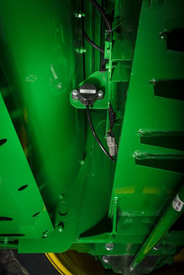 Active Terrain Adjustment pitch sensor
Active Terrain Adjustment pitch sensor Active Terrain Adjustment cleaning fan actuator
Active Terrain Adjustment cleaning fan actuatorWhen the machine starts an uphill climb, Active Terrain Adjustment will slow the cleaning fan down and open the chaffer and sieve elements. As the machine descends a hill, the cleaning fan speed will increase and the chaffer and sieve elements will close to decrease grain loss and prevent shoe loading.
ICA2 Retrofit Bundle for S780 and S790 Combines - BXE11035
Mirrors
Miscellaneous
105-mm (4-in.) Axle Spacer - BH92136
12 In. (300 mm) Axle Spacer - HXE71480
16 In. (400 mm) Axle Spacer - HXE71479
165-mm (6.5-in.) Axle Spacer - BH92139
 S690 Combine with manual grain tank extensions
S690 Combine with manual grain tank extensionsS680 and S690 Combines are equipped with manual-folding grain tank extensions and fewer covers in base equipment. Power-folding grain tank extensions/covers with a folding grain tank loading auger is available as optional equipment. The 400-bu manual-fold grain tank extension attachment allows for the conversion of power-folding covers to manual grain tank extensions.
454-mm (18-in.) axle spacer - BH92142
6 in. (155 mm) Axle Extension - BH92115
ActiveYield delivers automatic yield calibrations to the operator without spending time manually performing yield calibrations.
Feature benefit:
- Simplified yield calibrations for improved uptime in the field
- Simplified data collection for use during and after harvest

Functionality:
ActiveYield eliminates time-consuming manual yield calibrations and replaces them with automated sensors that calibrate the machine by measuring the grain as the tank fills. This enables decisions to be made in real time without leaving the cab.
 ActiveYield sensors in grain tank
ActiveYield sensors in grain tankWhen the ActiveYield option is enabled and the Terrain Compensation Module (TCM) in the StarFire™ 3000 or StarFire 6000 Receiver has been calibrated, ActiveYield is ready to go to work. As grain is harvested and enters the tank, the three sensors within the grain tank collectively measure the grain as it piles over the cross auger covers. If all conditions are acceptable (header and separator on, grain is flowing, and machine level is within 4 degrees) load collection occurs from 900 through 3000 kg (2000 through 6600 lb).
Any pitch and roll of more than 4 degrees from center during load collection will cause the system to reject that load due to the grain pile shifting in the tank. A new calibration load starts once grain is below the sensors on the cross auger covers.
Stored calibration loads are replaced by new ones as the system continues to collect data. The system may be disabled at any time by accessing the moisture setup page and unchecking the ActiveYield box if manual yield calibration is desired.
 ActiveYield calibration location
ActiveYield calibration location ActiveYield Information
ActiveYield InformationActiveYield is available for model year 2016 through model year 2019 S760, S770, S780, and S790 Combines and requires the 4600 CommandCenter™ Display, GreenStar™ 3 2630 Display, or GreenStar 3 CommandCenter. Additionally, a StarFire 3000 or 6000 Receiver must be installed on the combine with the TCM calibrated for ActiveYield to detect machine pitch correctly. Manual yield calibration is not required as each crop has a built-in default value.
Harvest Doc™ system yield data collected by an ActiveYield system is only compatible with the John Deere Operations Center. John Deere does not guarantee compatibility of ActiveYield collected documentation with John Deere APEX™ software or third-party software systems.
Chopper Drive Shielding - BXE10357
Deflector - PowerCast Tailboard - KXE10121
Distribution Kit - Standard Flex Residue - KXE10148
Driveshaft bundle, S-Series w/ No Axle Spacer - BH84580
Dyna-Flo Plus Chaffer - AXE48125
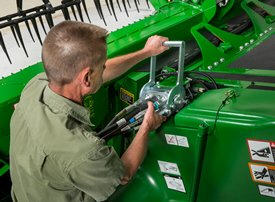 Enhanced single-point latching system
Enhanced single-point latching systemJohn Deere’s single-point header latching system provides combine operators a fast and easy method for connecting all front-end equipment. One easy motion of the lever connects the electrical and hydraulic circuits along with header retaining pins.
- No wrenches are required to complete the header-combine connection
- Reduces the time required to change over headers, so there is more time available for harvesting
- More convenient to remove headers for transport or storage
The enhanced single-point latching system, starting in model year 2016, will include a valve assembly mounted to all platform and corn head back sheets. These assemblies will include an orifice valve unique to the header type as well as a pressure override valve. Together, these ensure optimum performance and reliability of header hydraulic functions.
Compatibility for prior headers or combines to model year 2016 equipment is provided by attachments specific to the header and combine being used. Refer to the chart below for compatibility information.
Six different attachments cover the compatibility between new and used combines and front-end equipment. The attachments are BXE10667, BXE10666, BXE10668, BXE10670, BXE10697, and BXE10669.


 Enhanced single-point latching system
Enhanced single-point latching systemJohn Deere’s single-point header latching system provides combine operators a fast and easy method for connecting all front-end equipment. One easy motion of the lever connects the electrical and hydraulic circuits along with header retaining pins.
- No wrenches are required to complete the header-combine connection
- Reduces the time required to change over headers, so there is more time available for harvesting
- More convenient to remove headers for transport or storage
The enhanced single-point latching system, starting in model year 2016, will include a valve assembly mounted to all platform and corn head back sheets. These assemblies will include an orifice valve unique to the header type as well as a pressure override valve. Together, these ensure optimum performance and reliability of header hydraulic functions.
Compatibility for prior headers or combines to model year 2016 equipment is provided by attachments specific to the header and combine being used. Refer to the chart below for compatibility information.
Six different attachments cover the compatibility between new and used combines and front-end equipment. The attachments are BXE10667, BXE10666, BXE10668, BXE10670, BXE10697, and BXE10669.


Extra-Fine-Cut Chopper with American Power Conversion (APC) Outlet - BXE10170
Flex Residue Straw Spreader with Integrated Chaff Spreading, In-Cab Variable, Single Speed Control - BXE10358
Perforated and Clean Grain Doors - BH90075
The large tool cabinet is available on model year 2019 and newer combines models.
- Integrated design can fold away on the left-hand side of the combine with a hinge at ground level, so the toolbox does not have to be completely removed from the machine.
- 117-L (4.1-cu ft) of storage on two decks
- Compartment can be locked with a key
 Two tool cabinet decks
Two tool cabinet decks Tool cabinet storage space
Tool cabinet storage spaceOperator's Station
Retrofit Kit for Foot Pegs - KXE10454
Ash tray and cigarette lighter attachment for S-Series cabs
Radio
Rear Axle With 2-Speed, 4-Wheel Drive
Axle spacers enable specific tire spacing for S-Series Combines. Reference the attached Ag Sales Manual S-Series tire spacing chart for specific tire, tire spacing, and recommended axle spacer information. The axle spacer attachments include axle spacers, attaching hardware, truss rods, couplers, and shaft extensions. Ladder extensions are typically required and ordered separately to provide the necessary clearance between the tires and ladder.
Please reference the following documents for more detailed information.
Axle spacers enable specific tire spacing for S-Series Combines. Reference the attached Ag Sales Manual S-Series tire spacing chart for specific tire, tire spacing, and recommended axle spacer information. The axle spacer attachments include axle spacers, attaching hardware, truss rods, couplers, and shaft extensions. Ladder extensions are typically required and ordered separately to provide the necessary clearance between the tires and ladder.
Please reference the following documents for more detailed information.
Axle spacers enable specific tire spacing for S-Series Combines. Reference the attached Ag Sales Manual S-Series tire spacing chart for specific tire, tire spacing, and recommended axle spacer information. The axle spacer attachments include axle spacers, attaching hardware, truss rods, couplers, and shaft extensions. Ladder extensions are typically required and ordered separately to provide the necessary clearance between the tires and ladder.
Please reference the following documents for more detailed information.
Axle spacers enable specific tire spacing for S-Series Combines. Reference the attached Ag Sales Manual S-Series tire spacing chart for specific tire, tire spacing, and recommended axle spacer information. The axle spacer attachments include axle spacers, attaching hardware, truss rods, couplers, and shaft extensions. Ladder extensions are typically required and ordered separately to provide the necessary clearance between the tires and ladder.
Please reference the following documents for more detailed information.
Axle spacers enable specific tire spacing for S-Series Combines. Reference the attached Ag Sales Manual S-Series tire spacing chart for specific tire, tire spacing, and recommended axle spacer information. The axle spacer attachments include axle spacers, attaching hardware, truss rods, couplers, and shaft extensions. Ladder extensions are typically required and ordered separately to provide the necessary clearance between the tires and ladder.
Please reference the following documents for more detailed information.
Axle spacers enable specific tire spacing for S-Series Combines. Reference the attached Ag Sales Manual S-Series tire spacing chart for specific tire, tire spacing, and recommended axle spacer information. The axle spacer attachments include axle spacers, attaching hardware, truss rods, couplers, and shaft extensions. Ladder extensions are typically required and ordered separately to provide the necessary clearance between the tires and ladder.
Please reference the following documents for more detailed information.
Axle spacers enable specific tire spacing for S-Series Combines. Reference the attached Ag Sales Manual S-Series tire spacing chart for specific tire, tire spacing, and recommended axle spacer information. The axle spacer attachments include axle spacers, attaching hardware, truss rods, couplers, and shaft extensions. Ladder extensions are typically required and ordered separately to provide the necessary clearance between the tires and ladder.
Please reference the following documents for more detailed information.
 Enhanced single-point latching system
Enhanced single-point latching systemJohn Deere’s single-point header latching system provides combine operators a fast and easy method for connecting all front-end equipment. One easy motion of the lever connects the electrical and hydraulic circuits along with header retaining pins.
- No wrenches are required to complete the header-combine connection
- Reduces the time required to change over headers, so there is more time available for harvesting
- More convenient to remove headers for transport or storage
The enhanced single-point latching system, starting in model year 2016, will include a valve assembly mounted to all platform and corn head back sheets. These assemblies will include an orifice valve unique to the header type as well as a pressure override valve. Together, these ensure optimum performance and reliability of header hydraulic functions.
Compatibility for prior headers or combines to model year 2016 equipment is provided by attachments specific to the header and combine being used. Refer to the chart below for compatibility information.
Six different attachments cover the compatibility between new and used combines and front-end equipment. The attachments are BXE10667, BXE10666, BXE10668, BXE10670, BXE10697, and BXE10669.


Parts Assembly - Box of Final Drive Axle Extensions - BH81747
Residue Disposal
APC Corn Kit - KXE10135
Adjustable Finger Rakes - KXE10296
Corn Kit OSB Cover - KXE10303
Deflector Windrow Convergence Kit - AH210317
Fine Cut Chopper with Standard VTB Outlet - BXE10172
Fine Cut Chopper with Standard VTB Outlet - BXE10660
Flex Residue Straw Spreader with Integrated Chaff Spreading, In-Cab Variable, Single Speed Control - BXE10181
Hydraulic Plus Electric for Advanced PowerCast Fine-Cut and Extra-Fine-Cut (FC and XFC) - BXE10817
Hydraulic Plus Electric for Advanced PowerCast Fine-Cut and Extra-Fine-Cut (FC and XFC) - BXE10893
 Hydraulics and electrics for spreaders
Hydraulics and electrics for spreaders
The twin-disc straw spreader system uses two large impellers to ensure uniform distribution of material from the separator and cleaning system. The spreader is recommended for use when tillage practices do not dictate fine sizing of crop residue.
Straw spreader options:
1. Standard straw spreader
- This spreader is not recommended for use with greater than 9.14-m (30-ft) platforms
2. Widespread straw spreader (not available on the S650)
- This spreader is recommended for use with 9.14-m (30-ft) to 12.2-m (40-ft) platforms
- On the S660-S690 speeds of the spreader can be independently controlled
- This spreader is not recommended for use in rice applications
 Hydraulics and electrics for spreaders
Hydraulics and electrics for spreaders
The twin-disc straw spreader system uses two large impellers to ensure uniform distribution of material from the separator and cleaning system. The spreader is recommended for use when tillage practices do not dictate fine sizing of crop residue.
Straw spreader options:
1. Standard straw spreader
- This spreader is not recommended for use with greater than 9.14-m (30-ft) platforms
2. Widespread straw spreader (not available on the S650)
- This spreader is recommended for use with 9.14-m (30-ft) to 12.2-m (40-ft) platforms
- On the S660-S690 speeds of the spreader can be independently controlled
- This spreader is not recommended for use in rice applications
Hydraulic Plus and Electric for PowerCast - BXE10364
Knife Kit - KXE10363
PowerCast Tailboard - BXE10174
Premium Chopper Vane Kit for 7.6m (25 Ft.) Spread Width - AH219763
Standard Deflectors - BXE10179
 Manual vane tailboard
Manual vane tailboard Manual vane tailboard mounted
Manual vane tailboard mountedThe manually adjustable vane tailboard design provides a residue spread pattern for platform cut widths up to and including 9.14 m (30 ft).
The manually adjustable vane tailboard allows simple vane angle adjustments from the ground. Manually adjust the vane position, as required, to meet the desired spread width.

